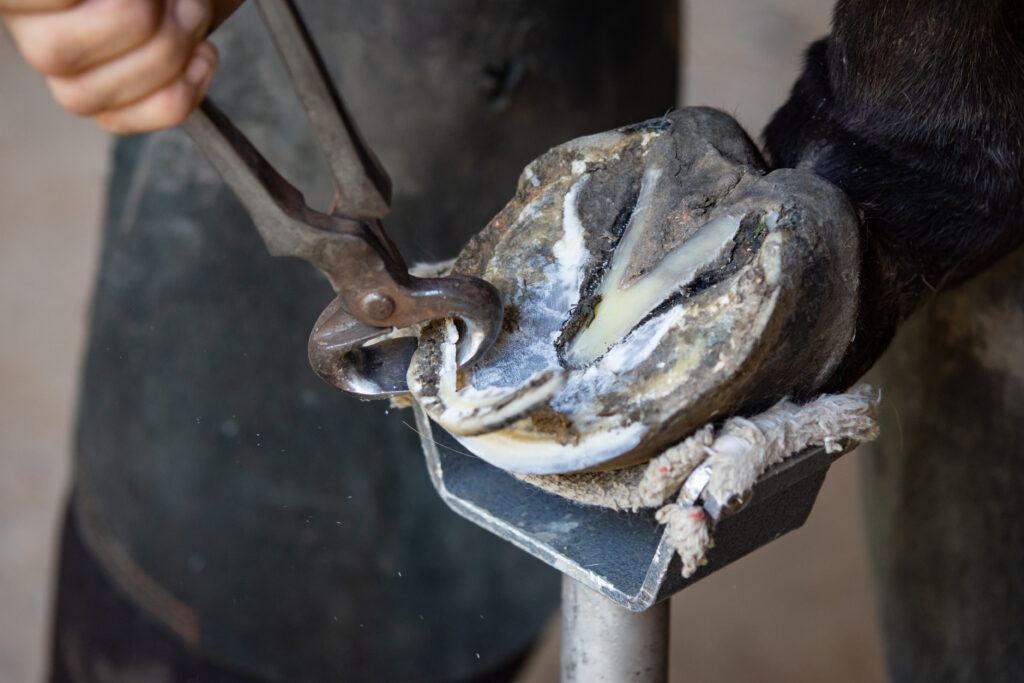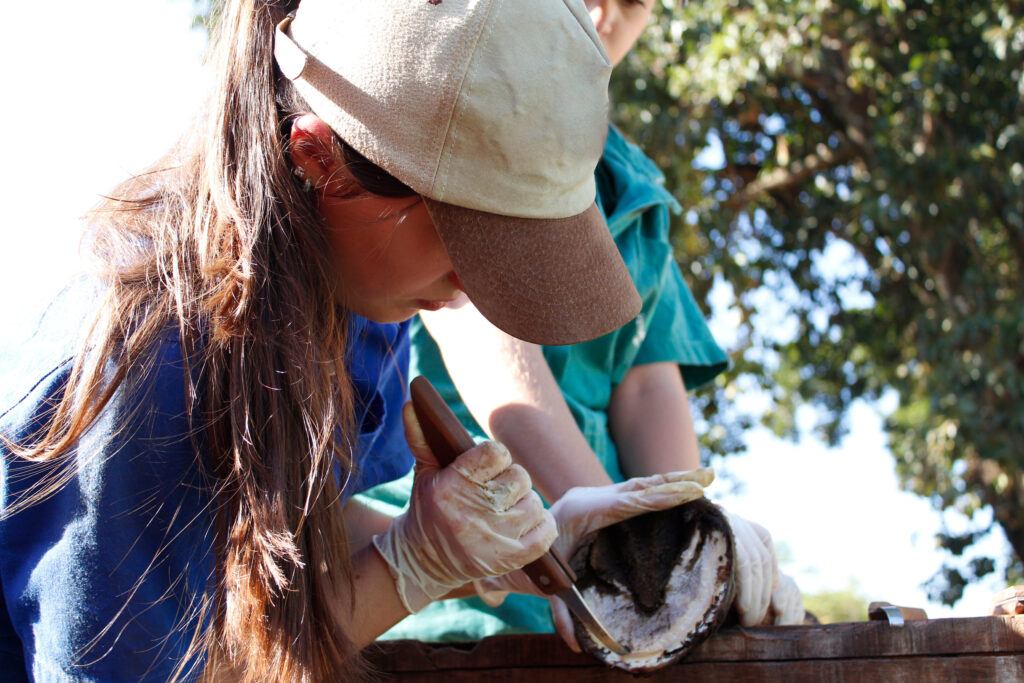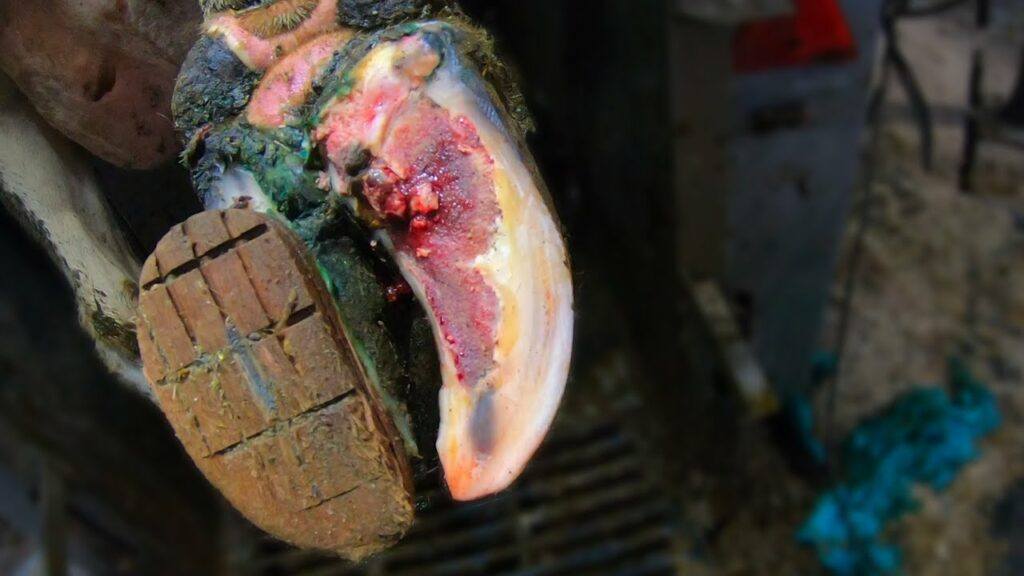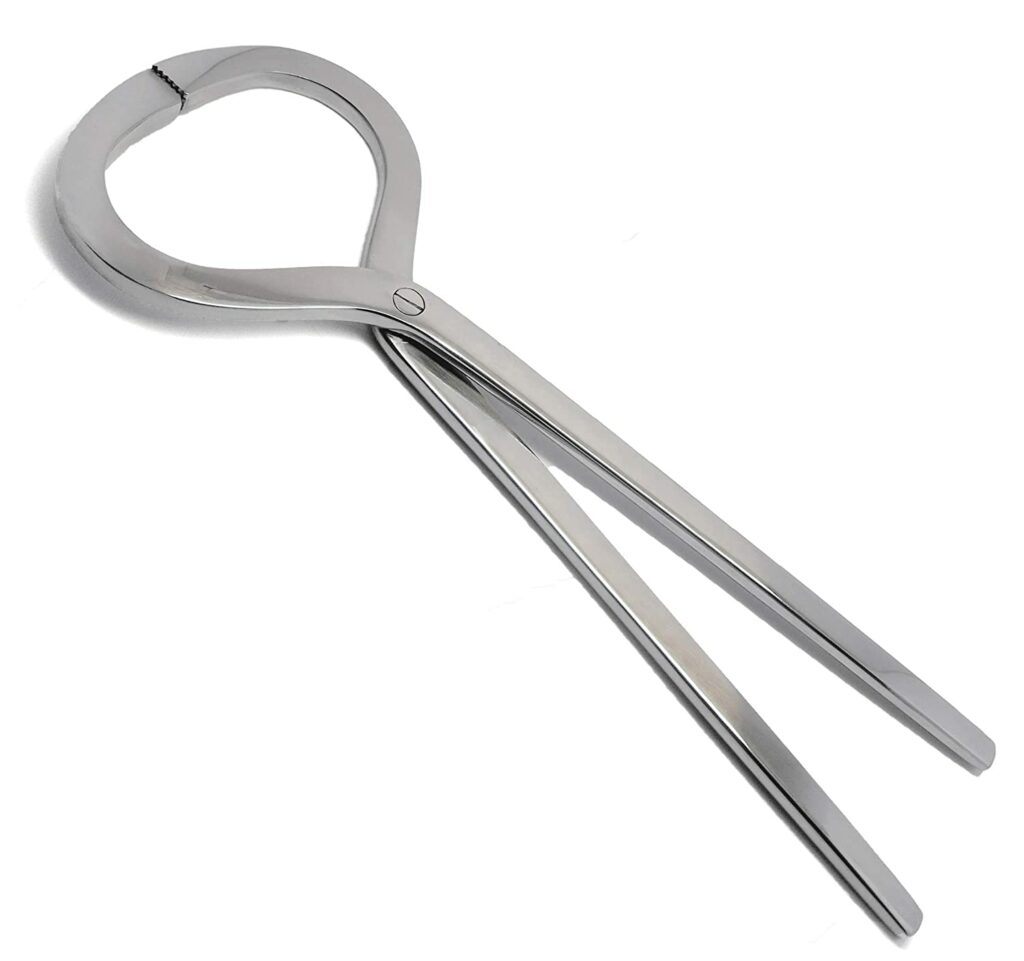Horse hoof abscess treatment is something every horse owner should be adept in – even if their horse, thus far, has never developed one. Why? Because most probably, at some point your horse will develop an abscess.
You should always have the necessary supplies on hand to treat an abscess.
Because abscesses develop quickly and look serious, you may be shocked at the physical symptoms. The pain of an abscess will make your horse limp. You may even think he has a broken leg.
This article will help you understand what a hoof abscess is, how to treat it, and how to keep an abscess from developing again. With proper care, your horse will be back under the saddle in no time.
What Is A Horse Hoof Abscess?
A hoof abscess is a localized bacterial infection in the hoof. It happens when bacteria gets trapped between the laminae, which is the tissue bonding the hoof capsule to the coffin bone, and the hoof wall or sole.
Often times, changes in moisture in the soil or environment are the trigger point for an abscess.
The white line along the surface of the hoof wall opens and closes and the periople (the wax-like hoof coating) can become compromised. When that happens, the hoof wall can crack and split, allowing bacteria to invade more sensitive parts of the hoof.
When Does a Horse Hoof Abscess Develop?
It usually takes several days to develop, and most horses only show signs of being lame when the pressure inside the hoof starts causing pain.
There’s an accumulation of puss, often accompanied by gas and inflammation. Because a hoof can’t expand to accommodate the inflammation, it can be quite painful. The pain levels can be severe enough that your horse will need medication for relief.
Additional Symptoms Of A Hoof Abscess
It’s possible that there will be no symptoms and you won’t know your horse has an abscess until it blows out.
Blowing out is when the puss seeks the path of least resistance to relieve the pressure, which is up the hoof wall. Usually it will break out at the coronary band. But it can break out through the bulbs of the heel too.
A horse with an abscess can have the following 6 symptoms:
1) Limping
2) Swelling in the lower leg (heel bulbs, coronary band, pastern). This is when the infection is actually moving up the leg.
3) Horse attempts to walk only on the front of his hoof (like walking on one’s toe)
4) Heat in the exterior hoof wall
5) Increased arterial pulse in the hoof
6) A drain track (where puss has drained after blowing out)
Find The Source of Pain
It can be more difficult to tell if your horse has an abscess or some other problem if it’s in a hind hoof and your horse is showing lameness. You’ll need to determine if the problem is in the hoof or if it’s higher in the leg. That’s because an injury to the hip or stifle will cause the same type of lameness as an abscess as far as appearance goes.
If your horse is showing lameness in a front leg, you can usually tell the problem is in the hoof if the horse is willing to flex the fetlock joint, knee, elbow, and shoulder. If he isn’t willing to flex those, the injury is more likely to be something other than an abscess.
One way to learn if it’s in the hoof is with a pair of hoof testers. Everyone who has a horse should own a pair. They’re inexpensive and easy to use. Your farrier or veterinarian can show you how to use them to find sensitive or painful places in your horse’s hooves.
If your horse has an abscess in a rear hoof, you may have to use the hoof tester to find it in the foot.
You may be able to see a black line on the bottom of the foot once you clean out any debris in the hoof. The black line (it isn’t a thin line…if it’s there, it’s probably fairly obvious) is the location of the abscess. But if the abscess is higher in the hoof, the black line may not be there.
Common Causes Hoof Abscesses
Some common causes of an abscess are:
A foreign item lodged in the foot
Going from shod to barefoot
Shoe nails too close to the laminae
Shoeing difficulties
Contracted heels
Bruising reaction
Laminitis
Navicular disease
Nail, screw, glass, or other object lodged in the foot (never pull these out)
Poor quality hooves
Poor hoof care
Wet weather
Wet, dirty stall
Hot, dry weather
Drastic change in weather…going from very wet to very dry and the reverse (very dry to very wet).
How to Treat an Abscess
Even if you know how, and plan to treat the abscess yourself, you should have your veterinarian examine your horse. If the horse is shod, the shoe will have to be pulled. Treatment is to drain the abscess, dry it out, let it heal, and prevent further infection.
Horse Hoof Abscess Treatment Tip #1
Cleaning The Abscess
Make sure no rocks, glass, nails, or wood chips are stuck in the frog or sulcus. Check the heel bulbs and sole too. If you do find a nail, screw, or some other object pierced into the foot. Do Not Pull It Out. Call your veterinarian.
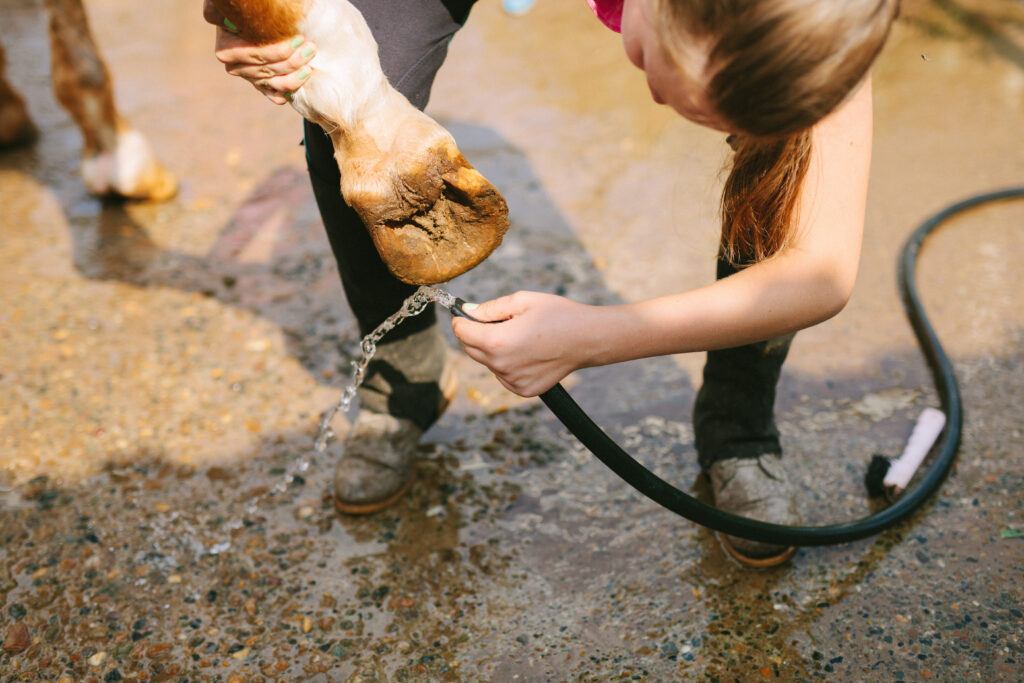
Your vet will need to know how far the object penetrated and if there is any damage deeper inside the hoof.
You’ll need to wrap the foot in cotton then use VetRap or Duct Tape to wrap around the cotton to protect the foot until your veterinarian can get there to examine it. You may need radiographs to see the extent of any damage. Call your veterinarian immediately.
Horse Hoof Abscess Treatment Tip #2
Soak Your Horse’s Foot
There are some commercial products you can use to soak your horse’s foot. Or you can make a solution of Betadine, Epsom salts, and warm water. This is your next step if cleaning debris out of your horse’s foot didn’t help. Soak the foot for 15 to 30 minutes then pack the foot with a poultice, an osmotic paste, or ichthammol.
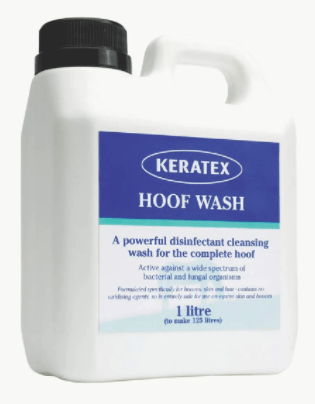
Horse Hoof Abscess Treatment Tip #3
Drain The Puss to Relieve Pressure
To treat an abscess, the puss has to be drained to relieve the pressure. If the black line (the area of infection) can be found, it may be possible to create a small hole in the sole or white line area to allow the puss to escape.
Many times when the hole is made, the puss, which will look black or brown tinted (and will smell nasty) will ooze out of the hoof.
Sometimes, the horse will need pain medication or local nerve blockers before the hole can be made. Normally, once the infection is drained, your horse will have immediate pain relief.
Horse Hoof Abscess Treatment Tip #4 Bandage Correctly
Once a hole is made, you must keep the hoof clean, packed (your vet will use an antiseptic bandage to keep the puss draining), and wrapped. Note, the bandages have to be changed daily.
And it will take from several days to a week in most cases for the lameness to disappear. You must keep the hoof bandaged until then. If the infection is deep inside the hoof, it will take longer for the infection to heal.
Your veterinarian can show you how to pack and wrap the hoof to keep it dry. You can even use a diaper over the hoof if necessary. There are hoof boots made for keeping a hoof clean and dry that you can purchase and have on hand for situations like this.
You will need to keep the horse in a clean, well-bedded stall or turned out in a small pen (turnout is the better option). Change the bandage every day until the draining has stopped and the hole stays dry and the lameness is gone.
Recovery Time
With a mild infection, the horse can usually return to working in less than a week. When the infection is deep, healing can take several weeks. It’s important to note that if a deep infection isn’t treated, it can lead to laminitis.
Horse Hoof Abscess Treatment Tip #5
Call Your Veterinarian If These Issues Occur
Drainage hasn’t stopped after 48 hours
Your horse shifts his weight frequently
Rests his good leg
Lies down more than usual
Doesn’t want to eat
Tissue grows from the drain hole
Needs pain medication for more than 2 days
How to Prevent Abscesses
It’s better to prevent an abscess than to treat one. These common sense measures can help keep your horse’s feet fit in tip top shape year round.
Maintain a regular farrier schedule. This is a key component to preventing abscesses. Without hoof care, the hoof wall will split, open up the white line and allow infection to move up into soft tissue structures.
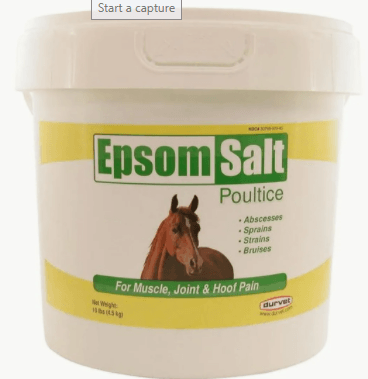
Use hoof dressing if your horse doesn’t have good hooves or periople (the waxy outer layer of the hoof). Products containing natural resins like pine tar and turpentine are the best options. Avoid petroleum products as they often aren’t as good as natural resins, and can be drying and a bit more irritating.
Avoid extremes of wet or dry conditions as both are damaging.
Wet conditions are damaging to the periople and will pull it away. Dry conditions make the hoof crack and open up the white line. Keep in mind that bedding stalls with dry shavings can be very drying to hooves.
Keep an eye out for objects in your horse’s turnout area that could cause problems if stepped on. Remove rocks that surface and anything else you find that shouldn’t be there. Consider shoeing a barefoot horse that doesn’t have good hooves.
Keeping the hoof shaped and off the ground can help avoid problems.
Conclusion
Most horses will have one or more abscesses throughout their life. But knowing how to recognize and treat them will go a long way toward keeping your horse sound and pain free. Taking reasonable precautions in stabling and hoof care will ward off a lot of hoof trouble and that should be your aim.
Even if your horse does develop an abscess, when you know how to manage the situation, your horse will be ready to go back to work in short order. One last tip… horses often buck when they’re in pain.
Was this post helpful? You may want to read my post “How to Stop a Horse from Bucking” to find out why your horse is bucking and what to do about its behavior.

